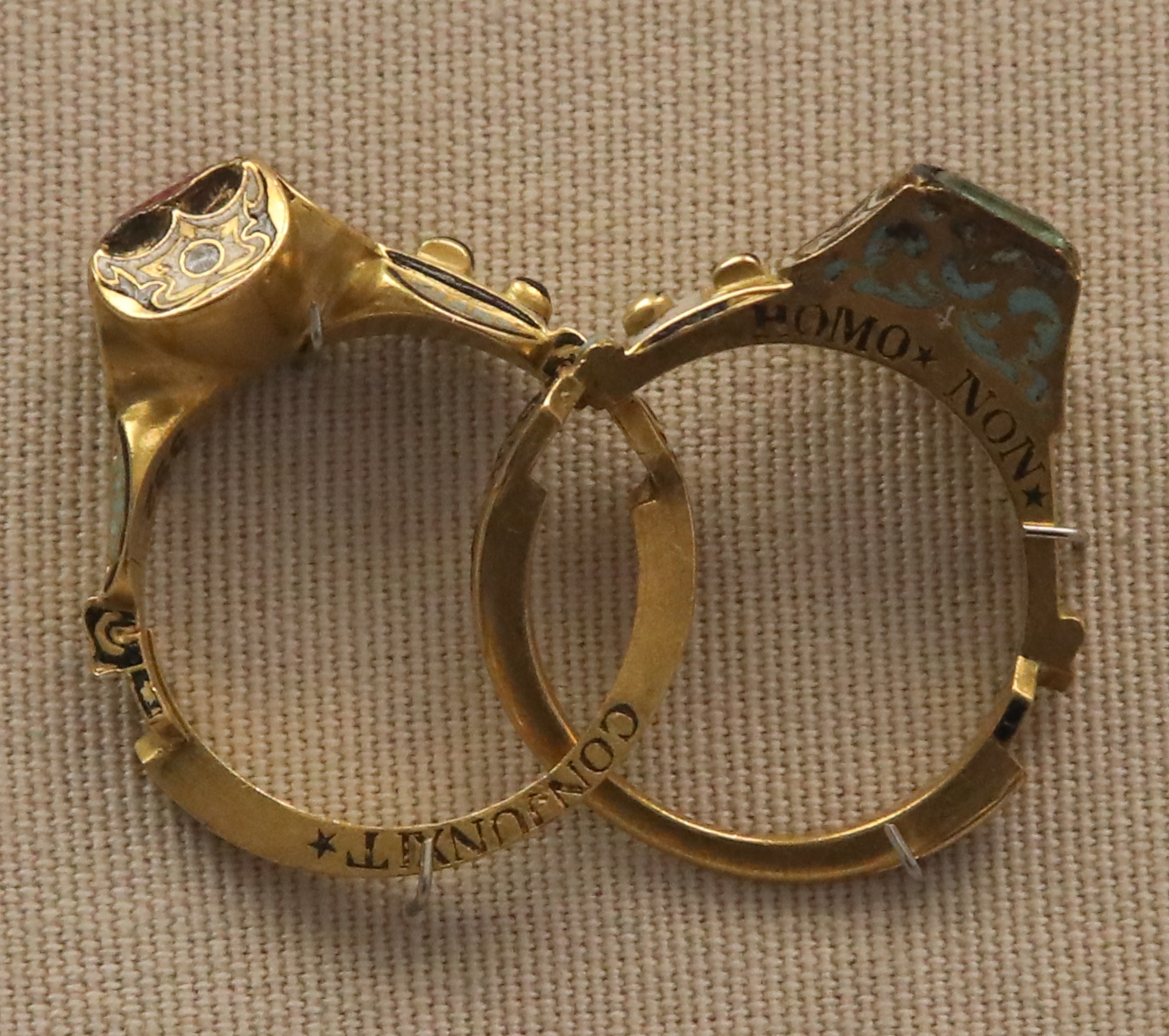Gimmel Ring on:
[Wikipedia]
[Google]
[Amazon]
 A gimmal ring, or gimmel ring, is a ring with two or three hoops or links that fit together to form one complete ring. The name gimmal comes from Latin ''gemellus'', twin, via Old French. They were known as joint rings in Elizabethan England.
In the 16th and 17th centuries, such rings were fashionable in
A gimmal ring, or gimmel ring, is a ring with two or three hoops or links that fit together to form one complete ring. The name gimmal comes from Latin ''gemellus'', twin, via Old French. They were known as joint rings in Elizabethan England.
In the 16th and 17th centuries, such rings were fashionable in
Gimmel ring
Rings (jewellery)
England
England is a Countries of the United Kingdom, country that is part of the United Kingdom. It is located on the island of Great Britain, of which it covers about 62%, and List of islands of England, more than 100 smaller adjacent islands. It ...
, Germany
Germany, officially the Federal Republic of Germany, is a country in Central Europe. It lies between the Baltic Sea and the North Sea to the north and the Alps to the south. Its sixteen States of Germany, constituent states have a total popu ...
, and other countries, and were often used as betrothal
An engagement or betrothal is the period of time between the declaration of acceptance of a marriage proposal and the marriage itself (which is typically but not always commenced with a wedding). During this period, a couple is said to be ''fi ...
rings. The engaged couple would wear one hoop each and rejoin them to use as a wedding ring. With triple link rings, a third person could witness the couple's vows and hold the third part of the ring until the marriage.
An early gimmal band, consisting of two interlocked rings sculpted to form a single ring, is to be found in the Victoria and Albert Museum
The Victoria and Albert Museum (abbreviated V&A) in London is the world's largest museum of applied arts, decorative arts and design, housing a permanent collection of over 2.8 million objects. It was founded in 1852 and named after Queen ...
, dated to 1350. Henry III of England
Henry III (1 October 1207 – 16 November 1272), also known as Henry of Winchester, was King of England, Lord of Ireland, and Duke of Aquitaine from 1216 until his death in 1272. The son of John, King of England, King John and Isabella of Ang ...
met the Count of Gynes
The gyne (, from Greek γυνή, "woman") is the primary reproductive female Caste (biology), caste of social insects (especially ants, wasps, and bees of order Hymenoptera, as well as termites). Gynes are those destined to become queens, wherea ...
in 1202 and gave him a gimmal ring set with a ruby and two emeralds. Martin Luther
Martin Luther ( ; ; 10 November 1483 – 18 February 1546) was a German priest, Theology, theologian, author, hymnwriter, professor, and former Order of Saint Augustine, Augustinian friar. Luther was the seminal figure of the Reformation, Pr ...
wed Catherine Bora in 1525 with a gimmal ring inscribed "Whom God has joined together, Let no man put asunder".The Power of Love, Levi, Karen editor,1988, Diamond Information Centre, London
Around 1600, the gimmal ring began to sometimes incorporate the clasped hands of the fede ring
A fede ring is a ring in which two hands clasp, as if in friendship, love or betrothal. The design was used in Ancient Rome, maybe earlier. It became prominent in the Middle Ages
In the history of Europe, the Middle Ages or medieval p ...
and a third symbol, a heart, was added, sometimes with a third shank. Designs involving clasped hands, and sometimes a heart, remained popular after the Renaissance
The Renaissance ( , ) is a Periodization, period of history and a European cultural movement covering the 15th and 16th centuries. It marked the transition from the Middle Ages to modernity and was characterized by an effort to revive and sur ...
. Similar imagery is found on other love rings, including claddagh rings.
The Benjamin Zucker collection in the Walters Museum
The Walters Art Museum is a public art museum located in the Mount Vernon neighborhood of Baltimore, Maryland. Founded and opened in 1934, it holds collections from the mid-19th century that were amassed substantially by major American art an ...
in Baltimore contains two elaborate gimmal rings incorporating small hidden enameled sculptural details visible only when the bands are separated. By the late 18th century, multiple shanks of five or more were made, sometimes collected at the back by a pivot, so they hinged like a fan.
Cultural references
There are several references to gimmal rings in Shakespeare's plays, including a joint-ring mentioned in ''Othello
''The Tragedy of Othello, the Moor of Venice'', often shortened to ''Othello'' (), is a tragedy written by William Shakespeare around 1603. Set in Venice and Cyprus, the play depicts the Moorish military commander Othello as he is manipulat ...
''. Robert Herrick's poem ''The Jimmall Ring or True-Love Knot'' (1648) is founded on a gimmal (jimmall) ring.
A gimmal ring is important to characters in Dryden's '' Don Sebastian'' (1690), which includes the passage:
A curious artist wrought 'em, With joynts so close as not to be perceiv'd; Yet are they both each other's counterpart.
See also
* Puzzle ring, which was probably derived from gimmal ringsReferences
{{ReflistSources
*Diana Scarisbrick
Diana Mary Innes Scarisbrick (née Wood; 8 October 1928 – 30 December 2024) was an English art historian specialising in the history of jewellery and engraved gems.
Life and career
Born 8 October 1928 at Echuca, Victoria, Australia, to Engli ...
, Takayuki Toyama, Kanji Hashimoto, ''Historic Rings: Four Thousand Years of Craftsmanship'' (2004)
Gimmel ring
Rings (jewellery)